Research on the Preparation of Graphene Quantum Dots/SBS Composite-Modified Asphalt and Its Application Performance
Abstract
:1. Introduction
2. Materials and Methods
2.1. Materials
2.2. Preparation of GQDs/SBS Modifier
2.3. Structural Analysis of GQDs/SBS Modifier
2.3.1. FT-IR Spectral Analysis
2.3.2. Thermogravimetric Analysis (TGA)
2.4. Preparation of Modified Asphalt
2.5. Performance Characterization of Modified Asphalt
2.5.1. Characterization of Physical Properties of Modified Asphalt
2.5.2. Rheological Test
2.6. Performance Characterization of Asphalt Mixture
3. Results and Discussions
3.1. Chemical Properties of Modifiers
3.1.1. FTIR Functional Group Analysis
3.1.2. TGA
3.2. Conventional Physical Properties of Modified Asphalt
3.3. Rheological Properties of Modified Asphalt
3.3.1. Frequency Scanning under Middle and High Temperature
3.3.2. Temperature Scanning
3.3.3. MSCR
3.3.4. Low-Temperature Creep Properties
4. Pavement Performance Test Analysis of Mixture
4.1. High-Temperature Stability
4.2. Low-Temperature Crack Resistance
4.3. Water Stability
5. Conclusions
- (1)
- The GQDs/SBS composite modifier is prepared by the simple Pickering emulsion polymerization method. GQDs can evenly disperse into the SBS modifier to form a uniform composite. The GQDs/SBS composite modifier contains more oxygen-containing functional groups than the SBS modifier. Furthermore, the pyrolysis rate of the GQDs/SBS composite modifier is lower than the SBS modifier, and its residual mass is higher, thus showing better thermostability.
- (2)
- The conventional physical properties and rheological properties of the GQDs/SBS composite-modified asphalt and SBS-modified asphalt are compared. The GQDs/SBS composite-modified asphalt shows a higher softening point, complex shear modulus, activation energy, rutting factor and recovery rate than the SBS-modified asphalt, thus showing better high-temperature performance. However, the cone penetration and ductility of the GQDs/SBS composite-modified asphalt decrease while S/m increases, indicating that its low-temperature performance is worsened.
- (3)
- The pavement performance of the GQDs/SBS composite-modified asphalt mixture and SBS-modified asphalt mixture are compared. The high-temperature stability of the GQDs/SBS composite-modified asphalt mixture is improved to some extent compared to that of the SBS-modified asphalt mixture, while its water stability changes slightly and the low-temperature performance declines to some extent.
Author Contributions
Funding
Institutional Review Board Statement
Informed Consent Statement
Data Availability Statement
Acknowledgments
Conflicts of Interest
References
- Gong, X.; Shao, C. The Gray Superiority Analysis of Asphalt Pavement Performance Evaluation Index and Main Diseases. In Proceedings of the 2009 Second International Conference on Intelligent Computation Technology and Automation, Washington, DC, USA, 10–11 October 2009; pp. 806–808. [Google Scholar]
- Zhao, P.; Dong, M.; Yang, Y.; Shi, J.; Wang, J.; Wu, W.; Zhao, X.; Zhou, X.; Wang, C. Research on the Mechanism of Surfactant Warm Mix Asphalt Additive-Based on Molecular Dynamics Simulation. Coatings 2021, 11, 1303. [Google Scholar] [CrossRef]
- Zhao, P.; Ren, R.; Zhou, H.; Ouyang, J.; Li, Z.; Sun, D. Preparation and properties of imidazoline surfactant as additive for warm mix asphalt. Constr. Build. Mater. 2021, 273, 121692. [Google Scholar] [CrossRef]
- Zhao, P.; Song, X.; Dong, M.; Sun, H.; Wu, W.; Zhang, R.; Sun, M.; Zhao, X. Preparation and characterization of CQDs/SBS composites and its application performance as asphalt modifier. Constr. Build. Mater. 2022, 320, 126312. [Google Scholar] [CrossRef]
- Zhu, C.; Zhang, H.; Zhang, Y. Influence of layered silicate types on physical, rheological and aging properties of SBS modified asphalt with multi-dimensional nanomaterials. Constr. Build. Mater. 2019, 228, 116735. [Google Scholar] [CrossRef]
- Sun, L.; Xin, X.; Ren, J. Asphalt modification using nano-materials and polymers composite considering high and low temperature performance. Constr. Build. Mater. 2017, 133, 358–366. [Google Scholar] [CrossRef]
- Li, X.K.; Chen, G.S.; Duan, M.W.; Yang, W.C.; Tang, S.C.; Cao, Y.D.; Luo, Y. Branched Hydroxyl Modification of SBS Using Thiol-Ene Reaction and Its Subsequent Application in Modified Asphalt. Ind. Eng. Chem. Res. 2017, 56, 10354–10365. [Google Scholar] [CrossRef]
- Bhat, F.S.; Mir, M.S. A study investigating the influence of nano Al2O3 on the performance of SBS modified asphalt binder. Constr. Build. Mater. 2021, 271, 121499. [Google Scholar] [CrossRef]
- Martínez-Anzures, J.D.; Zapién-Castillo, S.; Salazar-Cruz, B.A.; Rivera-Armenta, J.L.; Antonio-Cruz RD, C.; Hernández-Zamora, G.; Méndez-Hernández, M.L. Preparation and properties of modified asphalt using branch SBS/nanoclay nanocomposite as a modifier. Road Mater. Pavement Des. 2019, 20, 1275–1290. [Google Scholar] [CrossRef]
- Golestani, B.; Nam, B.H.; Nejad, F.M.; Fallah, S. Nanoclay application to asphalt concrete: Characterization of polymer and linear nanocomposite-modified asphalt binder and mixture. Constr. Build. Mater. 2015, 91, 32–38. [Google Scholar] [CrossRef]
- Nura, B.; Ibrahim, K.; Madzlan, N.; Hartadi, S.M. Polymer Nanocomposite-Modified Asphalt: Characterisation and Optimisation Using Response Surface Methodology. Arab. J. Sci. Eng. 2018, 44, 4233–4243. [Google Scholar]
- Alhamali, D.I.; Wu, J.; Liu, Q.; Hassan, N.A.; Yusoff NI, M.; Ali SI, A. Physical and rheological characteristics of polymer modified bitumen with nanosilica particles. Arab. J. Sci. Eng. 2016, 41, 1521–1530. [Google Scholar] [CrossRef]
- Zhang, H.-L.; Su, M.-M.; Zhao, S.-F.; Zhang, Y.-P.; Zhang, Z.-P. High and low temperature properties of nano-particles/polymer modified asphalt. Constr. Build. Mater. 2016, 114, 323–332. [Google Scholar] [CrossRef]
- Kh, A.; Cy, A.; Qy, B.; Yc, A.; Gc, A.; Rong, M.C. Multi–scale enhancement mechanisms of graphene oxide on styrene–butadiene–styrene modified asphalt: An exploration from molecular dynamics simulations. Mater. Des. 2021, 208, 109901. [Google Scholar]
- Wang, R.; Yue, M.; Xiong, Y.; Yue, J. Experimental study on mechanism, aging, rheology and fatigue performance of carbon nanomaterial/SBS-modified asphalt binders. Constr. Build. Mater. 2020, 268, 121189. [Google Scholar] [CrossRef]
- Mamun, A.A.; Arifuzzaman, M. Nano-scale moisture damage evaluation of carbon nanotube-modified asphalt. Constr. Build. Mater. 2018, 193, 268–275. [Google Scholar] [CrossRef]
- Liu, K.; Zhu, J.; Zhang, K.; Wu, J.; Yin, J.; Shi, X. Effects of mixing sequence on mechanical properties of graphene oxide and warm mix additive composite modified asphalt binder. Constr. Build. Mater. 2019, 217, 301–309. [Google Scholar] [CrossRef]
- Zhu, J.; Zhang, K.; Liu, K.; Shi, X. Performance of hot and warm mix asphalt mixtures enhanced by nano-sized graphene oxide. Constr. Build. Mater. 2019, 217, 273–282. [Google Scholar] [CrossRef]
- Stratiev, D.; Shishkova, I.; Dinkov, R.; Kirilov, K.; Yordanov, D.; Nikolova, R.; Veli, A.; Tavlieva, M.; Vasilev, S.; Suyunov, R.R. Variation of oxidation reactivity of straight run and H-Oil hydrocracked vacuum residual oils in the process of road asphalt production. Road Mater. Pavement Des. 2021. [Google Scholar] [CrossRef]
- Stratiev, D.; Nenov, S.; Nedanovski, D.; Shishkova, I.; Dinkov, R.; Stratiev, D.D.; Stratiev, D.D.; Sotirov, S.; Sotirova, E.; Atanassova, V.; et al. Empirical Modeling of Viscosities and Softening Points of Straight-Run Vacuum Residues from Different Origins and of Hydrocracked Unconverted Vacuum Residues Obtained in Different Conversions. Energies 2022, 15, 1755. [Google Scholar] [CrossRef]
- Santagata, E.; Baglieri, O.; Tsantilis, L.; Dalmazzo, D. Rheological characterization of bituminous binders modified with carbon nanotubes. Procedia-Soc. Behav. Sci. 2012, 53, 546–555. [Google Scholar] [CrossRef] [Green Version]
- Goli, A.; Ziari, H.; Amini, A. Influence of carbon nanotubes on performance properties and storage stability of SBS modified asphalt binders. J. Mater. Civ. Eng. 2017, 29, 04017070. [Google Scholar] [CrossRef]
- Chakraborty, A.K.; Coleman, K.S.; Dhanak, V.R. The electronic fine structure of 4-nitrophenyl functionalized single-walled carbon nanotubes. Nanotechnology 2009, 20, 155704. [Google Scholar] [CrossRef] [PubMed]
- Li, L.; Wu, G.; Yang, G.; Peng, J.; Zhao, J.; Zhu, J.-J. Focusing on luminescent graphene quantum dots: Current status and future perspectives. Nanoscale 2013, 5, 4015–4039. [Google Scholar] [CrossRef] [PubMed] [Green Version]
- Ponomarenko, L.A.; Schedin, F.; Katsnelson, M.I.; Yang, R.; Hill, E.W.; Novoselov, K.S.; Geim, A.K. Chaotic Dirac billiard in graphene quantum dots. Science 2008, 320, 356–358. [Google Scholar] [CrossRef] [Green Version]
- Zheng, X.T.; Ananthanarayanan, A.; Luo, K.Q.; Chen, P. Glowing graphene quantum dots and carbon dots: Properties, syntheses, and biological applications. Small 2015, 11, 1620–1636. [Google Scholar] [CrossRef]
- Zhao, P.; Yang, M.; Fan, W.; Wang, X.; Tang, F.; Yang, C.; Dou, X.; Li, S.; Wang, Y.; Cao, Y. Facile One-Pot Conversion of Petroleum Asphaltene to High Quality Green Fluorescent Graphene Quantum Dots and Their Application in Cell Imaging. Part. Part. Syst. Charact. 2016, 33, 635–644. [Google Scholar] [CrossRef]
- Zhang, L.; Yu, J.; Yang, M.; Xie, Q.; Peng, H.; Liu, Z. Janus graphene from asymmetric two-dimensional chemistry. Nat. Commun. 2013, 4, 1–7. [Google Scholar] [CrossRef] [Green Version]
- Ren, R.; Zhang, Z.; Zhao, P.; Shi, J.; Han, K.; Yang, Z.; Gao, D.; Bi, F. Facile and one-step preparation carbon quantum dots from biomass residue and their applications as efficient surfactants. J. Dispers. Sci. Technol. 2019, 40, 627–633. [Google Scholar] [CrossRef]
- Ren, R.; Han, K.; Zhao, P.; Shi, J.; Zhao, L.; Gao, D.; Zhang, Z.; Yang, Z. Identification of asphalt fingerprints based on ATR-FTIR spectroscopy and principal component-linear discriminant analysis. Constr. Build. Mater. 2019, 198, 662–668. [Google Scholar] [CrossRef]
- Shi, J.T.; Zhao, P.H.; Fan, W.Y.; Yang, Z.Q.; Lin, Y.; Ouyang, J. Facile preparation and application performance evaluation of SBS/C-9 petroleum resin blends as modifier for high viscosity asphalt. Constr. Build. Mater. 2020, 262, 120073. [Google Scholar] [CrossRef]
- Zhang, Q.; Gu, X.; Yu, Z.; Liang, J.; Dong, Q. Viscoelastic Damage Characteristics of Asphalt Mixtures Using Fractional Rheology. Materials 2021, 14, 5892. [Google Scholar] [CrossRef] [PubMed]
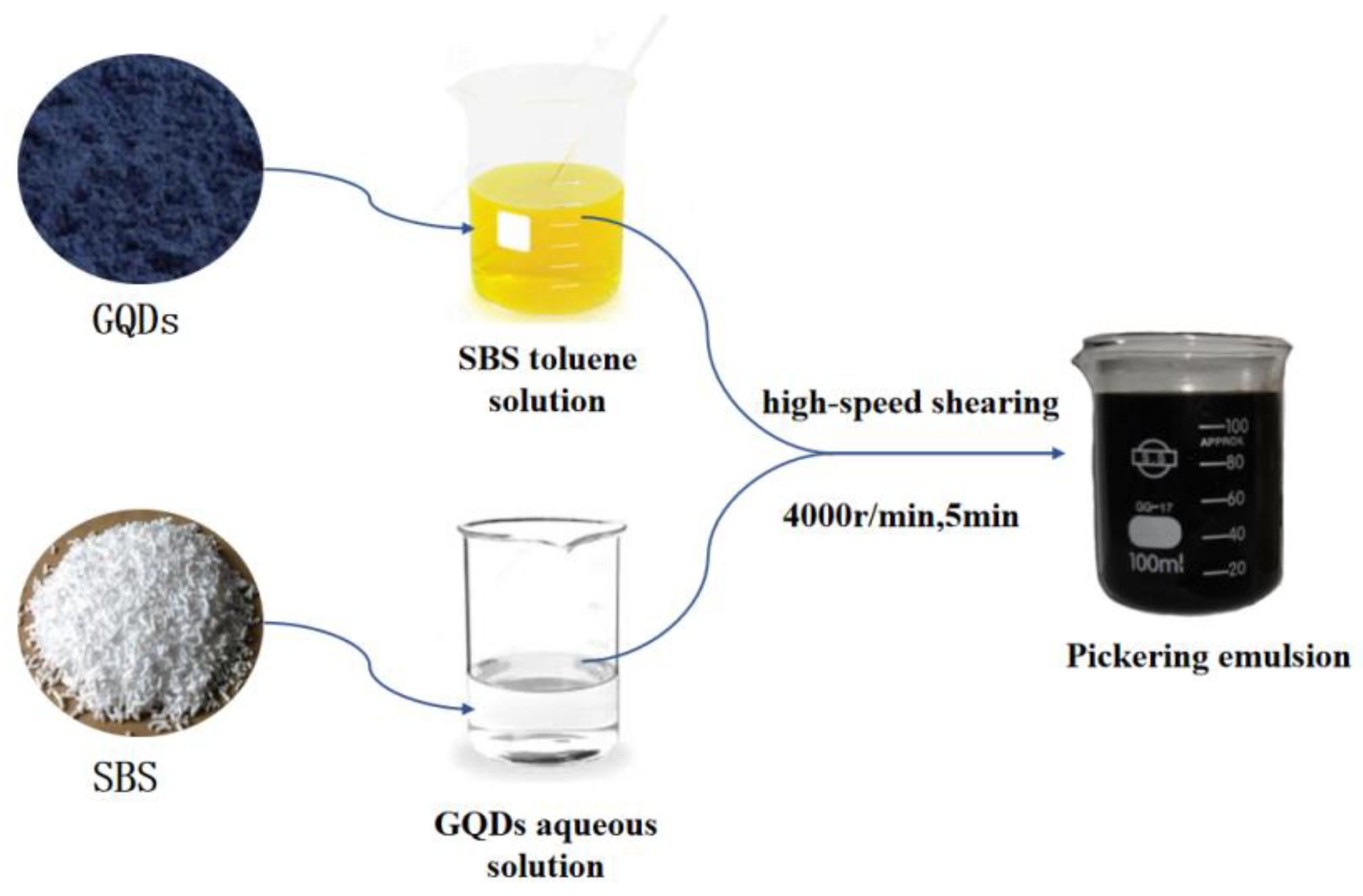


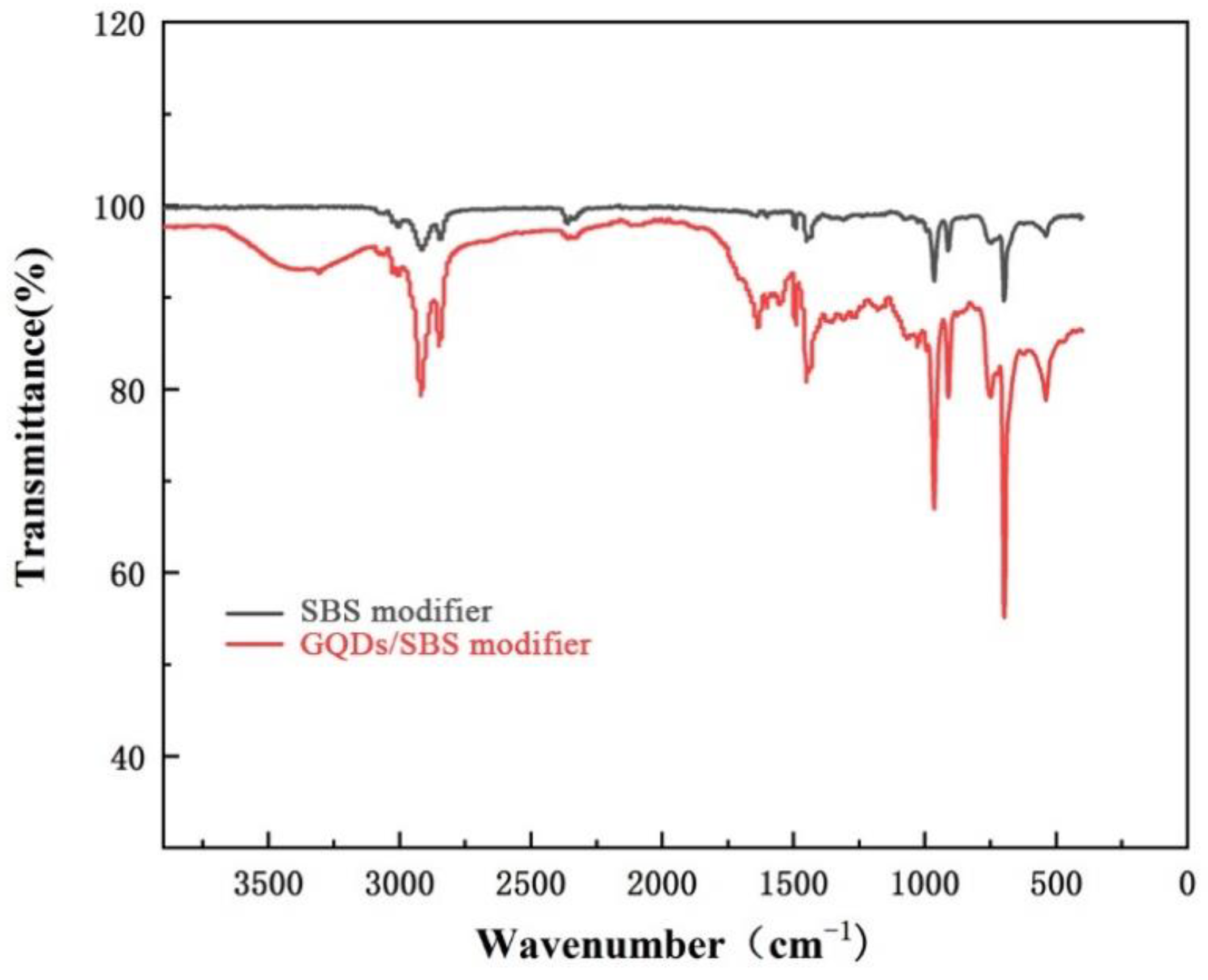

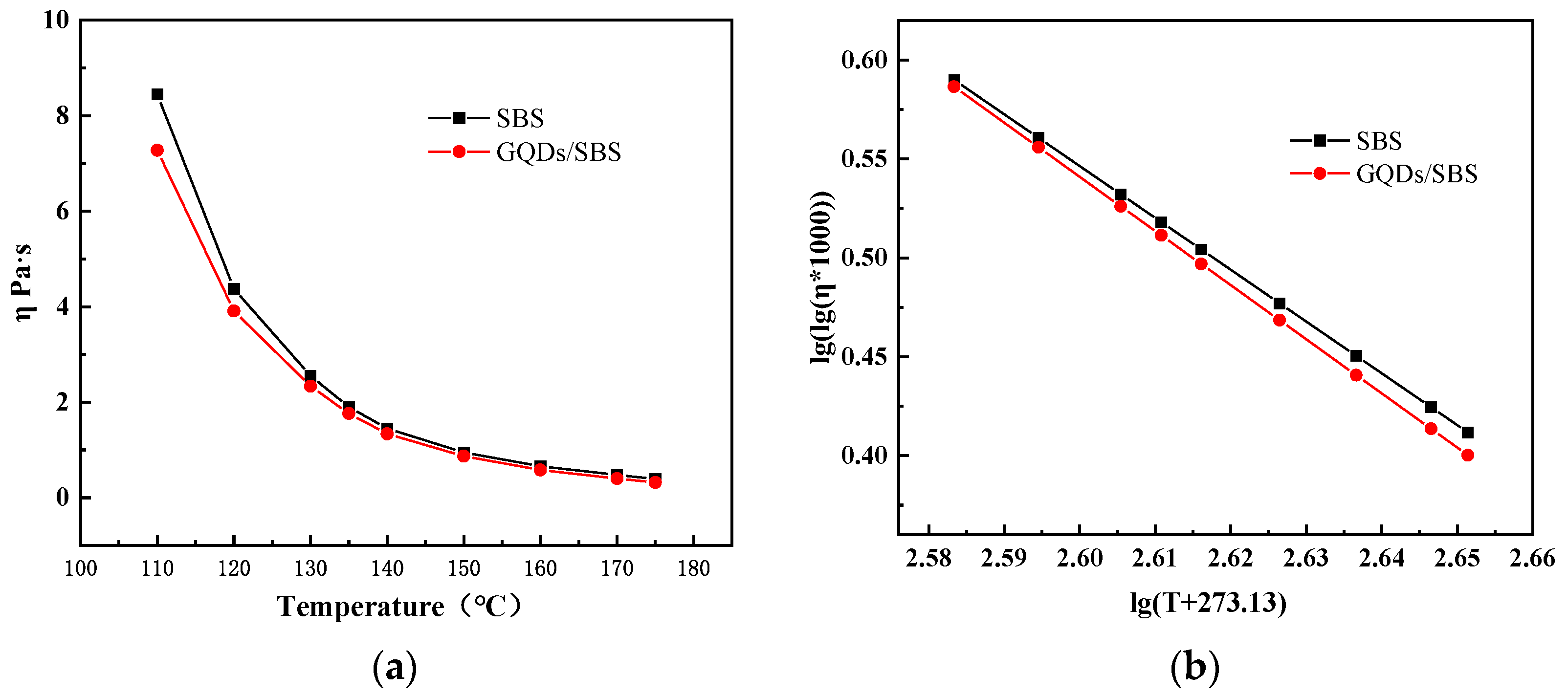
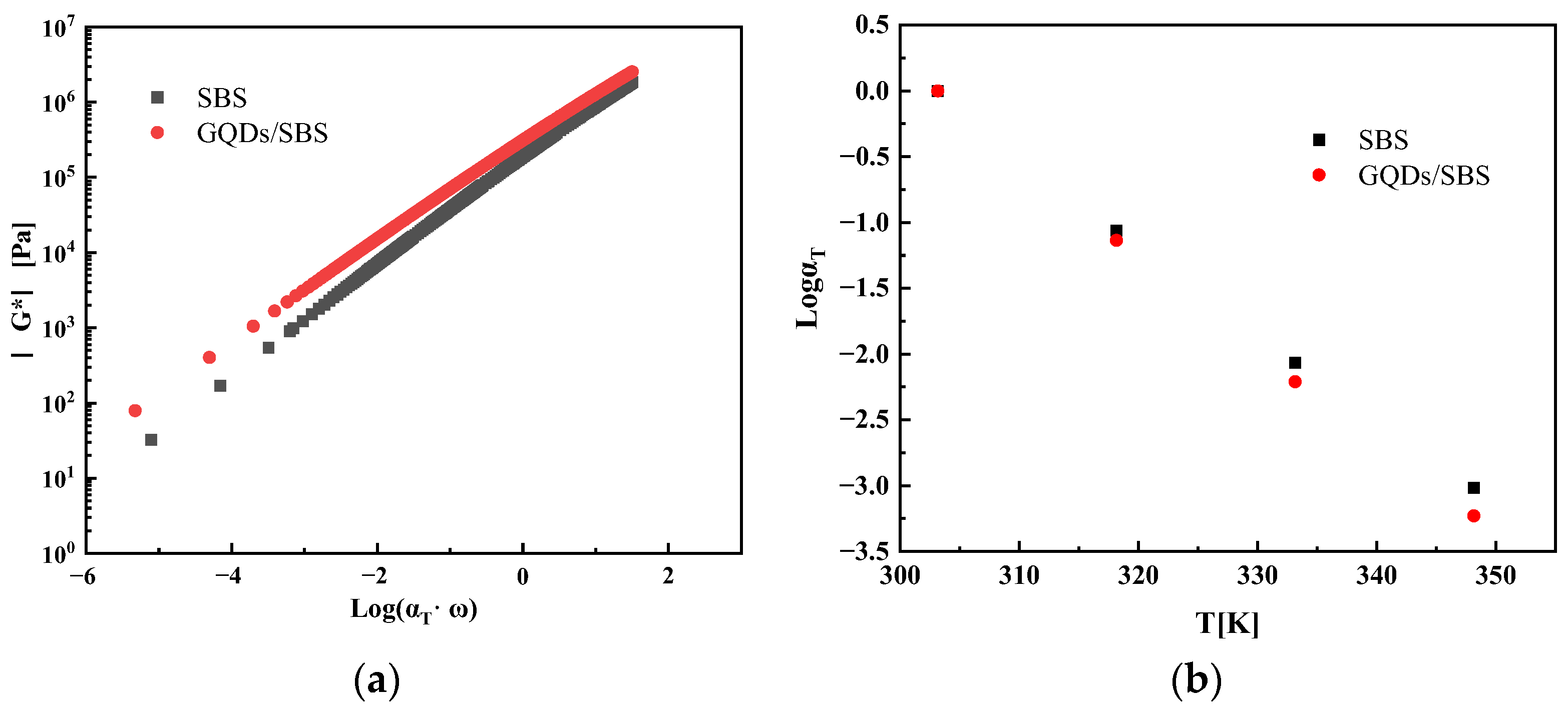

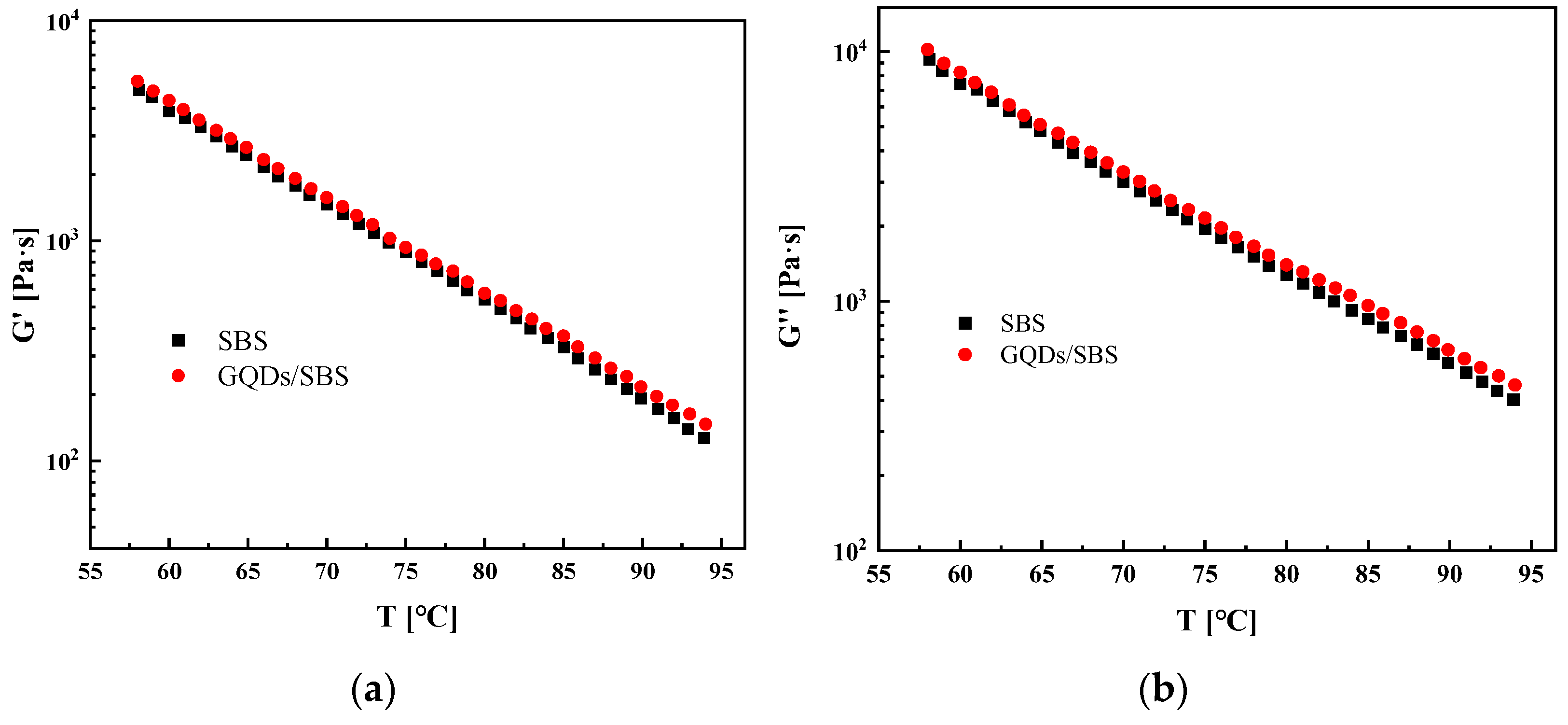
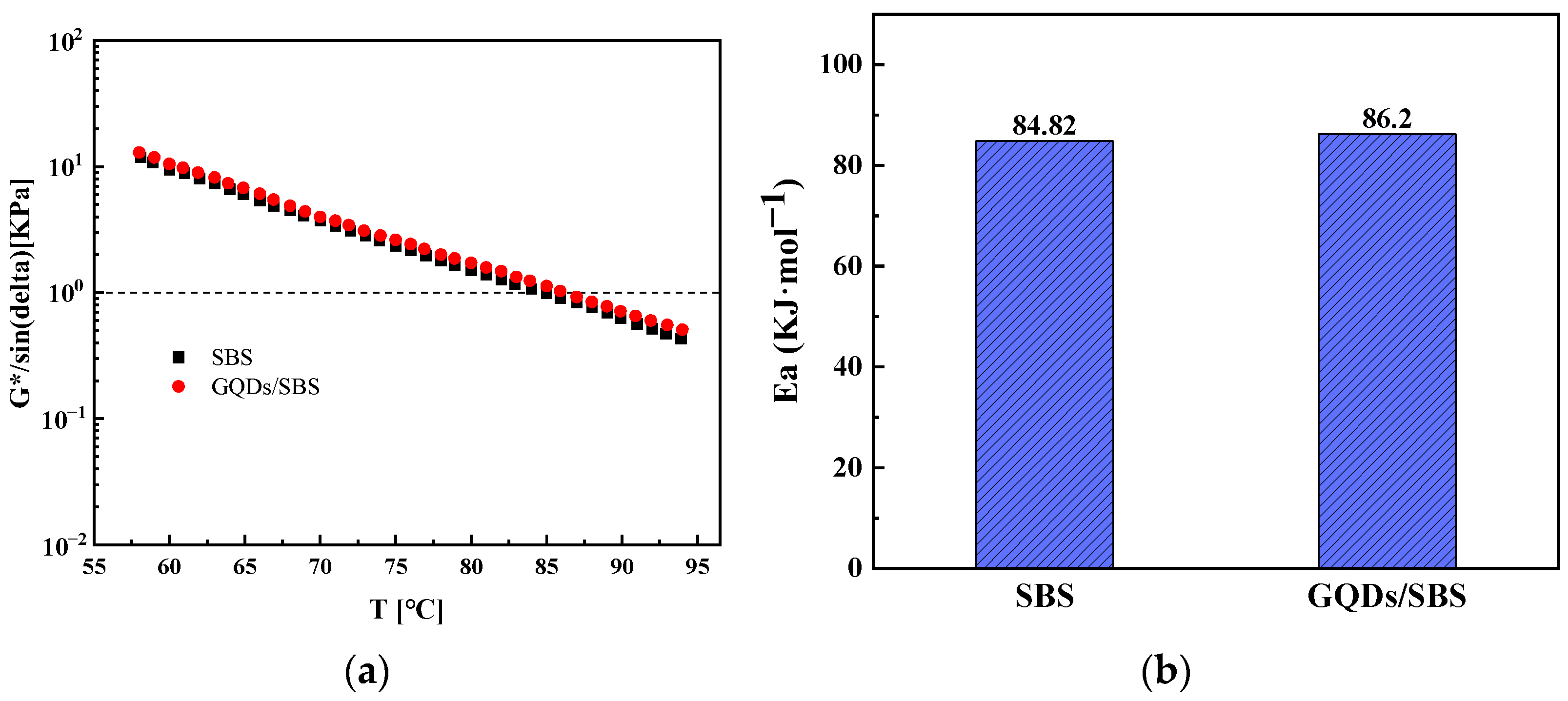
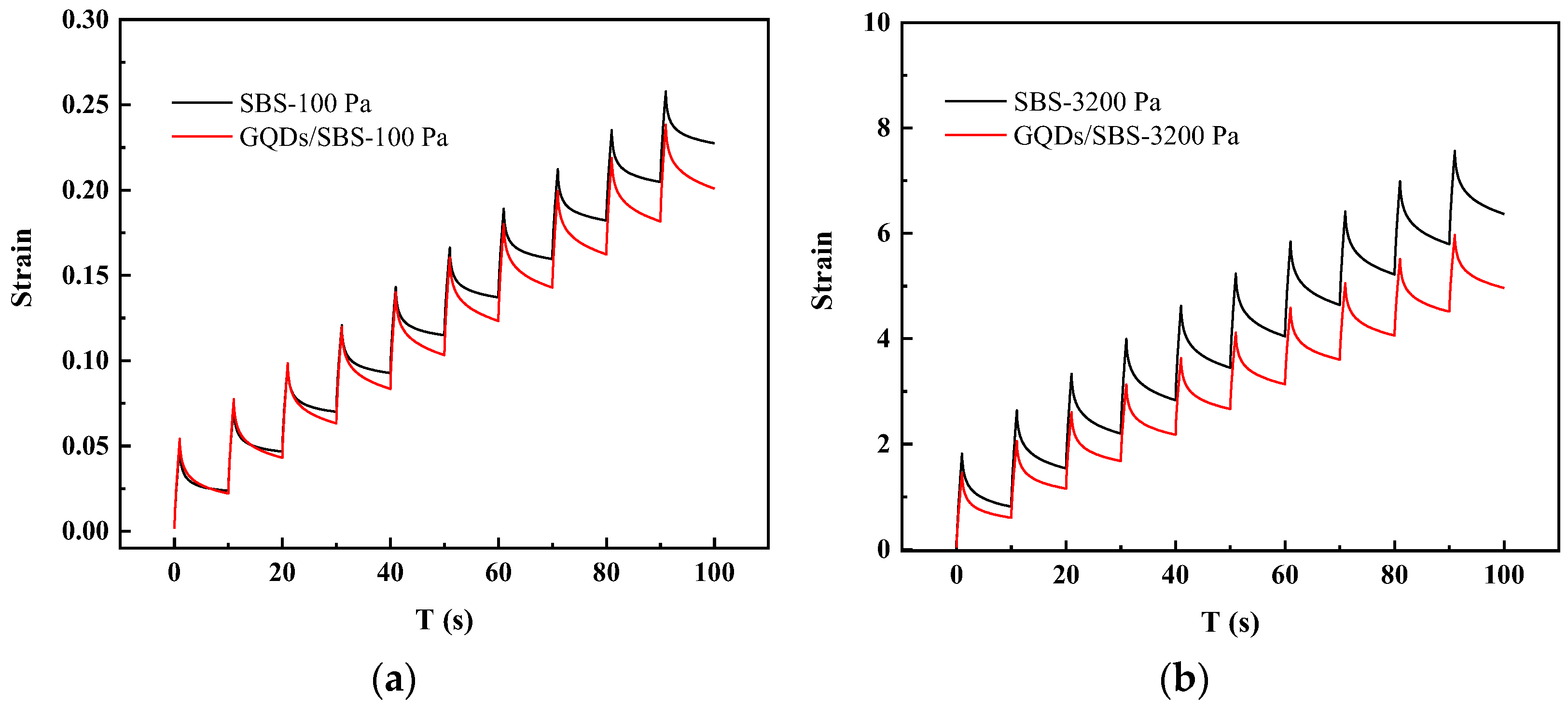


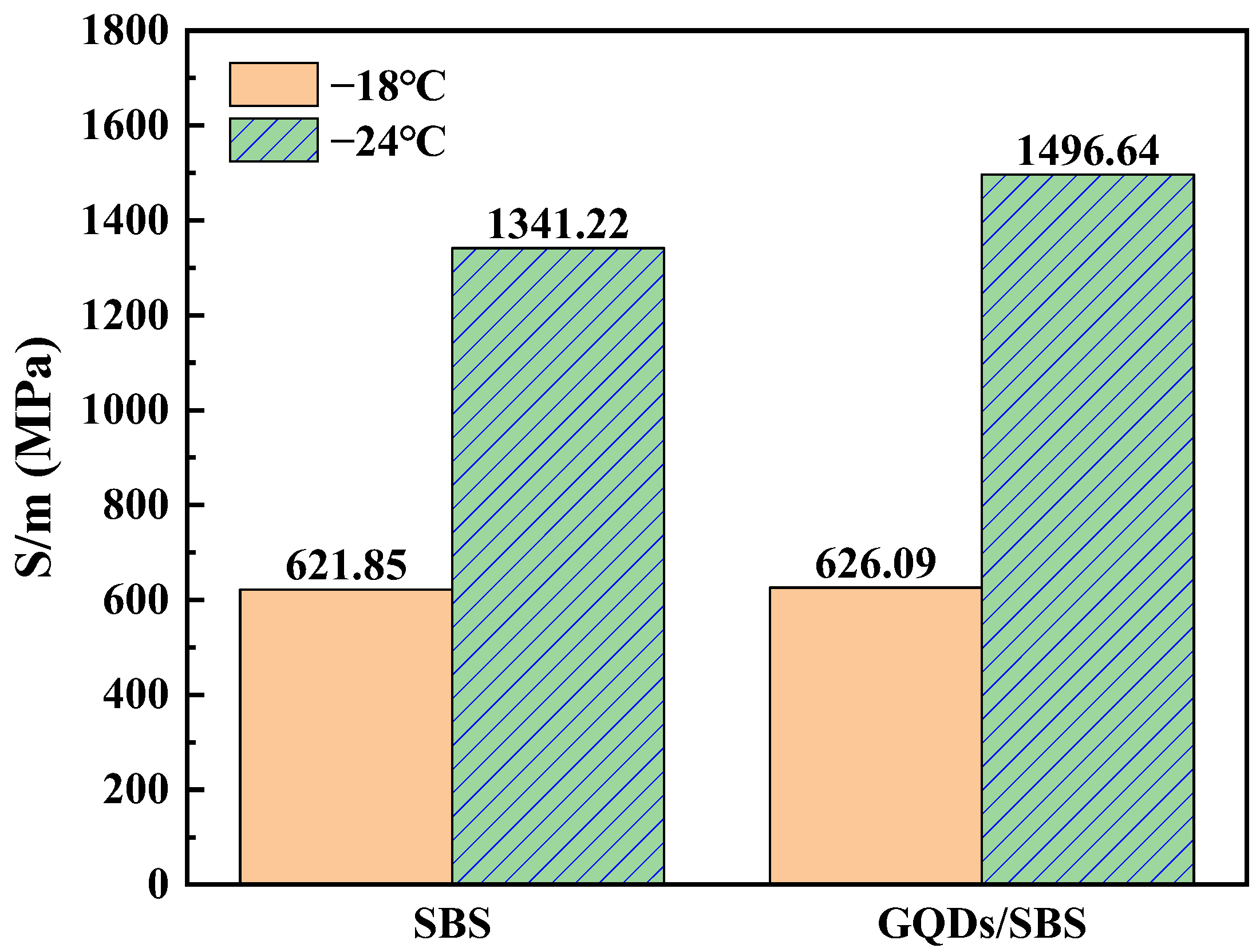
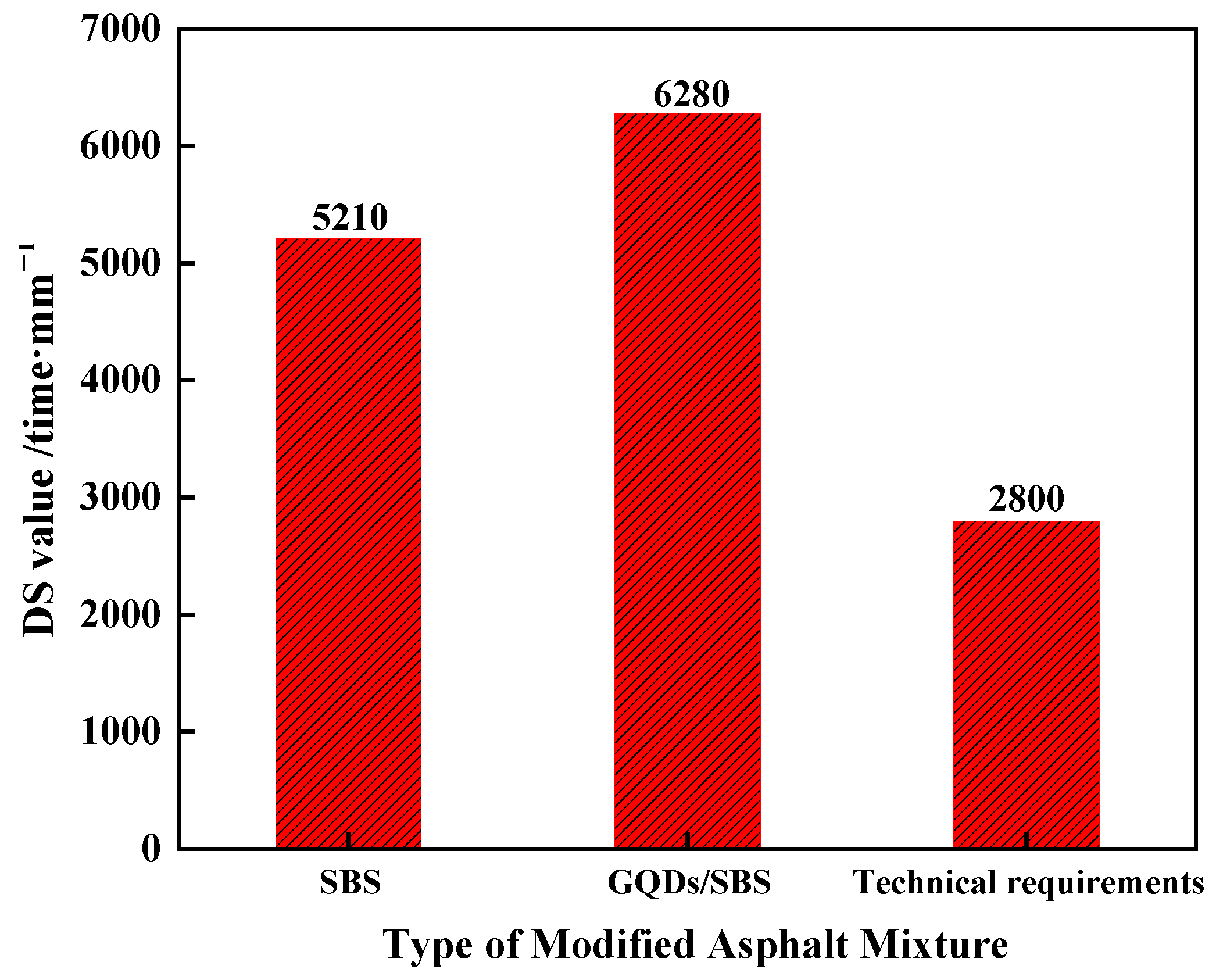

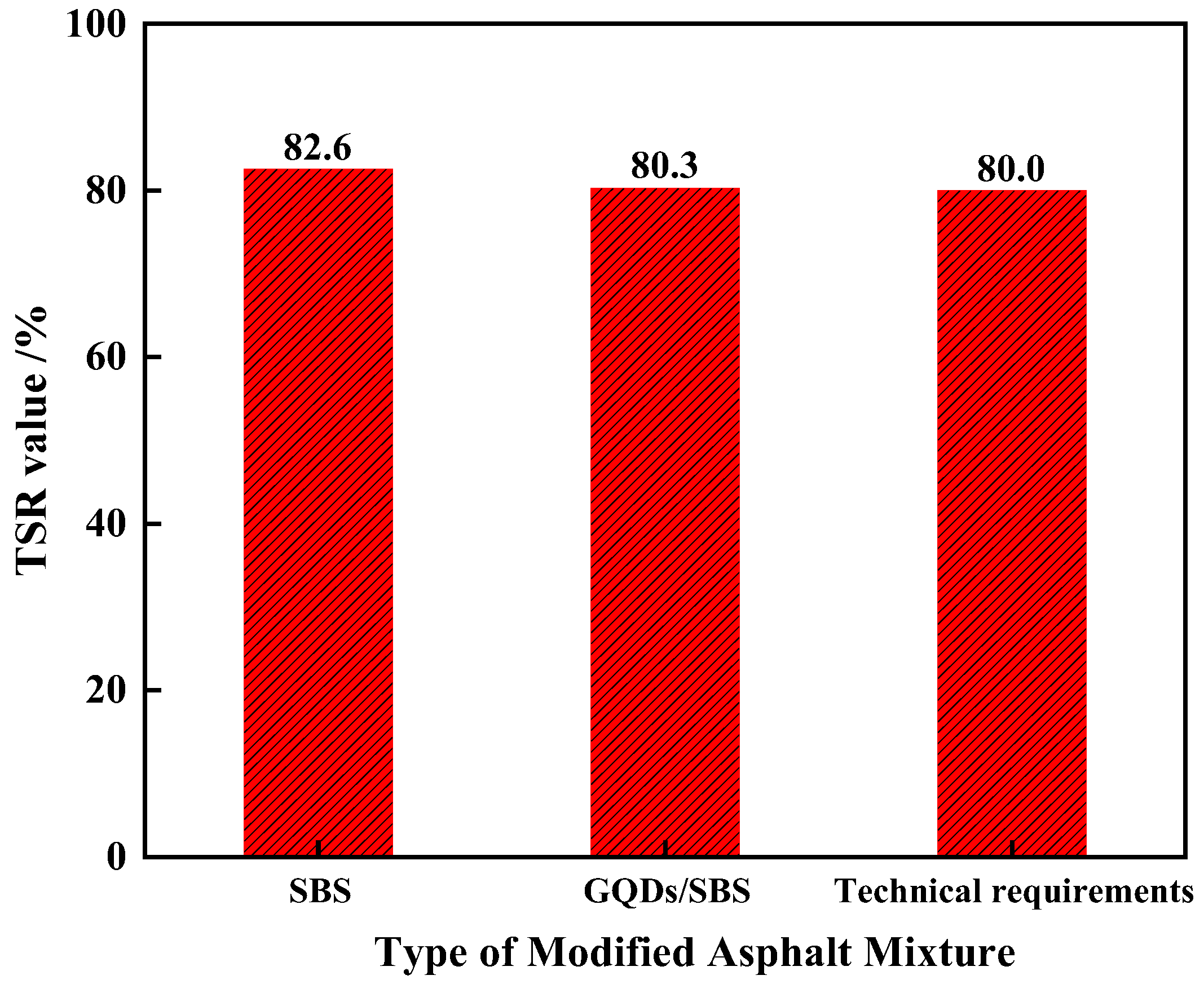
| Index | Units | Requirement | Results | |
|---|---|---|---|---|
| Penetration (25 °C, 5 s, 100 g) | 0.1 mm | 60–80 | 71 | |
| Softening point (R&B) | °C | ≥45 | 50.2 | |
| Ductility (10 °C) | cm | ≮15 | 35.7 | |
| Dynamic viscosity at 60 °C | Pa·s | ≮160 | 212 | |
| Four component | Saturates | % | -- | 17.8 |
| Aromatics | % | -- | 42.7 | |
| Resins | % | -- | 25.2 | |
| Asphaltenes | % | -- | 14.1 | |
| Modifier Type | TG | DTG | |||
|---|---|---|---|---|---|
| Starting Temperature/°C | Termination Temperature/°C | Residual Mass/% | Peak Temperature/°C | Pyrolysis Rate/%/min | |
| SBS | 416.0 | 479.9 | 0.05 | 455.4 | −17.08 |
| GQDs/SBS | 415.3 | 478.8 | 1.78 | 454.7 | −16.23 |
| Index | SBS | GQDs/SBS | Test Method |
|---|---|---|---|
| Softening point/°C | 65.6 | 71.1 | T0606 |
| Penetration/0.1 mm | 51.6 | 47.9 | T0604 |
| Ductility(5 °C)/cm | 24.8 | 24.5 | T0605 |
| Asphalt Type | Viscosity–Temperature Curve Fitting Equation | VTS | R2 |
|---|---|---|---|
| SBS | lg(lgη*1000) = −2.6184 * (T + 273.13) + 7.3543 | −2.6184 | 0.99732 |
| GQDs/SBS | lg(lgη*1000) = −2.7364 * (T + 273.13) + 7.6555 | −2.7364 | 0.99959 |
Publisher’s Note: MDPI stays neutral with regard to jurisdictional claims in published maps and institutional affiliations. |
© 2022 by the authors. Licensee MDPI, Basel, Switzerland. This article is an open access article distributed under the terms and conditions of the Creative Commons Attribution (CC BY) license (https://creativecommons.org/licenses/by/4.0/).
Share and Cite
Lu, Y.; Shi, N.; Wang, M.; Wang, X.; Yin, L.; Xu, Q.; Zhao, P. Research on the Preparation of Graphene Quantum Dots/SBS Composite-Modified Asphalt and Its Application Performance. Coatings 2022, 12, 515. https://doi.org/10.3390/coatings12040515
Lu Y, Shi N, Wang M, Wang X, Yin L, Xu Q, Zhao P. Research on the Preparation of Graphene Quantum Dots/SBS Composite-Modified Asphalt and Its Application Performance. Coatings. 2022; 12(4):515. https://doi.org/10.3390/coatings12040515
Chicago/Turabian StyleLu, Youfu, Nan Shi, Mingming Wang, Xinyang Wang, Liyang Yin, Qiang Xu, and Pinhui Zhao. 2022. "Research on the Preparation of Graphene Quantum Dots/SBS Composite-Modified Asphalt and Its Application Performance" Coatings 12, no. 4: 515. https://doi.org/10.3390/coatings12040515






